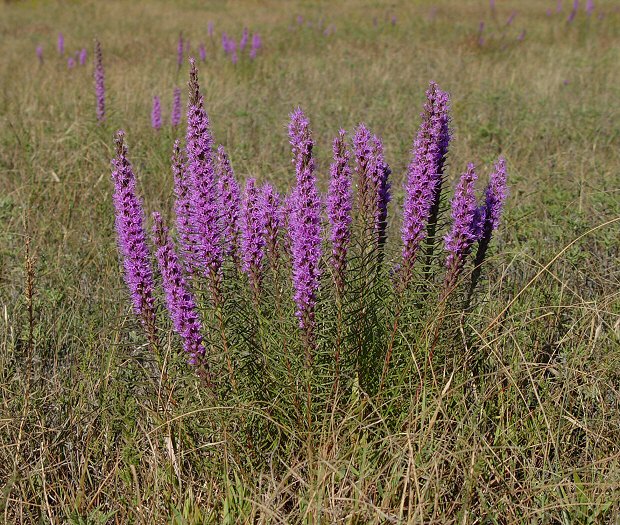Liatris punctata Hook.
Prairie Snakeroot

Native
CC = 10
CW = 5
MOC = 6
© DETenaglia
Liatris punctata Hook.Prairie Snakeroot | |
 |
Native CC = 10 CW = 5 MOC = 6 |
© DETenaglia |
|
Family - Asteraceae/Eupatorieae Habit - Perennial forb with a thickened, elongate taproot. Stems - Ascending to erect, to 90 cm, glabrous.
Leaves - Basal and lower stem leaves sessile to short-petiolate, the blades 7-15 cm long, 1-4 mm wide, linear, the narrow, light margins occasionally curled under, the surfaces glabrous but the margins of at least some leaves hairy, grayish green, with 1 main vein, grading toward the stem tip to shorter leaves, these mostly sessile, 1.5-12.0 cm long, linear.
Inflorescences - Elongate spikes, the heads densely spaced (the axis mostly not visible between heads), sessile or nearly so, with 1 basal bract.
Heads - Heads with 3-7 disc florets, the terminal head sometimes slightly longer than the others. Involucre 10-14 mm long, nearly cylindrical, with 4 or 5 unequal, overlapping series of bracts, the outer series appearing somewhat shorter. Involucral bracts broadly lanceolate to narrowly oblong-obovate, tapered to a sharply pointed, ascending to somewhat spreading tip, mostly with narrow, thin, pale to transparent margins, these sometimes slightly to strongly purplish-tinged, more or less entire but usually cobwebby-hairy, the main body appearing flat below the tip.
Florets - Corollas 9-11 mm long, glabrous. Pappus bristles plumose. Ray flowers absent.
Fruits - Achenes 5.5-7.5 mm long. Flowering - August - October. Habitat - Loess hill prairies, upland prairies. Origin - Native to the U.S. Lookalikes - Other species of Liatris, especially L. mucronata. Other info. - This attractive species is uncommon in Missouri, found thus far in only a few far-western counties. It becomes much more common just to our west, with a U.S. distribution occupying a wide belt in the central third of the country extending beyond the southern and northern borders. The plant is differentiated from several others by having plumose pappus bristles (an unfortunate character present in nearly every key to this genus), heads with only a few florets, and somewhat leathery leaves which are densely dotted with impressed glands. Distinguishing this species from L. mucronata can be challenging, sometimes relying on the shape of the root (globose vs. elongated and carrot-like). More study of the complex is needed. The flowers of both species are nearly always pink but plants with pure-white flowers are occasionally found. An example is shown below.
Current taxonomic understanding places Missouri plants in var. punctata. Photographs taken at Tall Grass Prairie National Preserve, KS., 9-24-06 (DETenaglia); also in Larimer County, CO, 7-31-2017 (SRTurner). |